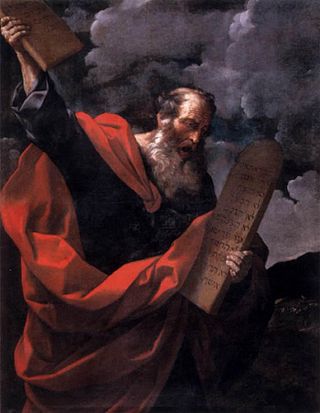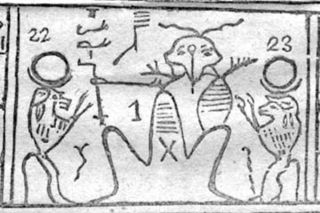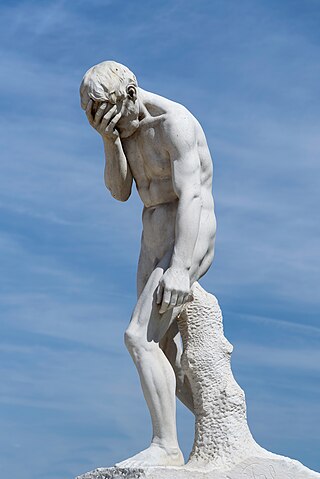
The Church of Jesus Christ of Latter-day Saints, informally known as the LDS Church or Mormon Church, is a restorationist, nontrinitarian Christian denomination that is the largest denomination in the Latter Day Saint movement. The church is headquartered in the United States in Salt Lake City, Utah and has established congregations and built temples worldwide. According to the church, it has over 17 million members and over 72,000 full-time volunteer missionaries. The church was the fourth-largest Christian denomination in the United States as of 2012, and reported over 6.8 million US members as of 2022.

Moses was a Hebrew teacher and leader considered the most important prophet in Judaism and one of the most important prophets in Christianity, Islam, the Druze Faith, the Baháʼí Faith, Samaritanism, and Rastafarianism. According to both the Bible and the Quran, Moses was the leader of the Israelites and lawgiver to whom the prophetic authorship of the Torah is attributed.

Sarah is a biblical matriarch, prophet, and major figure in Abrahamic religions. While different Abrahamic faiths portray her differently, Judaism, Christianity, and Islam all depict her character similarly, as that of a pious woman, renowned for her hospitality and beauty, the wife and half-sister of Abraham, and the mother of Isaac. Sarah has her feast day on 1 September in the Catholic Church, 19 August in the Coptic Orthodox Church, 20 January in the LCMS, and 12 and 20 December in the Eastern Orthodox Church.

The Book of Abraham is a collection of writings from several Egyptian scrolls discovered in the early 19th century during an archeological expedition by Antonio Lebolo. Members of the Church of Jesus Christ of Latter-day Saints purchased the scrolls from a traveling mummy exhibition on July 3, 1835, to be translated into English by Joseph Smith. According to Smith, the book was "a translation of some ancient records... purporting to be the writings of Abraham, while he was in Egypt, called the Book of Abraham, written by his own hand, upon papyrus". Smith said the papyri described Abraham's early life, his travels to Canaan and Egypt, and his vision of the cosmos and its creation.
Jerald Dee Tanner and Sandra McGee Tanner are American writers and researchers who publish archival and evidential materials about the history of the Church of Jesus Christ of Latter-day Saints. The Tanners founded the Utah Lighthouse Ministry (UTLM), whose stated mission is "to document problems with the claims of Mormonism and compare LDS doctrines with Christianity". As of 2022 Sandra Tanner continues to operate the ministry after Jerald's death in 2006.

Kolob is a star or planet described in the Book of Abraham, a sacred text of the Latter Day Saint movement. Several Latter Day Saint denominations hold the Book of Abraham to have been translated from an Egyptian papyrus scroll by Joseph Smith, the founder of the movement. According to this work, Kolob is the heavenly body nearest to the throne of God. While the Book of Abraham calls Kolob a "star", it also calls planets "stars", and therefore some Latter Day Saint commentators consider Kolob a planet. The body also appears in Latter Day Saint culture, including a reference to Kolob in an LDS hymn.
In Latter-day Saint theology, Egyptus is the name of two women in the Book of Abraham in the Pearl of Great Price. One is the wife of Ham, son of Noah, who bears his children. The other is their daughter, who discovered Egypt while "it was under water" (1:23-24). Three 1835 pre-publication manuscripts of the Book of Abraham, in place of "Egyptus", read Zeptah for the elder Egyptus and Egyptes for the younger Egyptus.
The House of Joseph is a designation which members of the Church of Jesus Christ of Latter-day Saints apply to the ancient "birthright" tribe of the house of Israel (Jacob) as it is described in the Old Testament, made up of the tribes of Ephraim and Manasseh. The tribes' namesakes — the two sons of Joseph of Egypt — are first mentioned in Genesis 41:50-52.
The Book of Moses, dictated by Joseph Smith, is part of the scriptural canon for some denominations in the Latter Day Saint movement. The book begins with the "Visions of Moses", a prologue to the story of the creation and the fall of man, and continues with material corresponding to the Joseph Smith Translation of the Bible's (JST) first six chapters of the Book of Genesis, interrupted by two chapters of "extracts from the prophecy of Enoch".

The Kinderhook plates are a set of six small, bell-shaped pieces of brass with unusual engravings, created as a hoax in 1843, surreptitiously buried and then dug up at an Native American mound near Kinderhook, Illinois, United States.

The curse of Cain and the mark of Cain are phrases that originated in the story of Cain and Abel in the Book of Genesis. In the stories, if someone harmed Cain, the damage would come back sevenfold. Some interpretations view this as a physical mark, whereas other interpretations see the "mark" as a sign, and not as a physical mark on Cain himself. The King James Version of the Bible reads "set a mark upon Cain".

In the Book of Genesis, the curse of Ham is described as a curse which was imposed upon Ham's son Canaan by the patriarch Noah. It occurs in the context of Noah's drunkenness and it is provoked by a shameful act that was perpetrated by Noah's son Ham, who "saw the nakedness of his father". The exact nature of Ham's transgression and the reason Noah cursed Canaan when Ham had sinned have been debated for over 2,000 years.

The Pearl of Great Price is part of the canonical Standard Works of the Church of Jesus Christ of Latter-day Saints and some other Latter Day Saint denominations.

The Joseph Smith Papyri (JSP) are Egyptian funerary papyrus fragments from ancient Thebes dated between 300 and 100 BC which, along with four mummies, were once owned by Joseph Smith, the founder of the Latter Day Saint movement. Smith purchased the mummies and papyrus documents from a traveling exhibitor in Kirtland, Ohio in 1835. Smith said that the papyrus contained the records of the ancient patriarchs Abraham and Joseph.

The Book of Abraham is a work produced between 1835 and 1842 by the Latter Day Saints (LDS) movement founder Joseph Smith that he said was based on Egyptian papyri purchased from a traveling mummy exhibition. According to Smith, the book was "a translation of some ancient records ... purporting to be the writings of Abraham, while he was in Egypt, called the Book of Abraham, written by his own hand, upon papyrus". The work was first published in 1842 and today is a canonical part of the Pearl of Great Price. Since its printing, the Book of Abraham has been a source of controversy. Numerous non-LDS Egyptologists, beginning in the mid-19th century, have heavily criticized Joseph Smith's translation and explanations of the facsimiles, unanimously concluding that his interpretations are inaccurate. They have also asserted that missing portions of the facsimiles were reconstructed incorrectly by Smith.

The standard works of Mormonism—the largest denomination of which is the Church of Jesus Christ of Latter-day Saints —have been the subject of various criticisms. Latter-day Saints believe the Book of Mormon is a sacred text with the same divine authority as the Bible; both are considered complementary to each other. Other Mormon sacred texts include the Pearl of Great Price and Doctrine and Covenants, which are also recognized as scripture. Religious and scholarly critics outside Mormonism have disputed Mormonism's unique scriptures, questioning the traditional narrative of how these books came to light and the extent to which they describe actual events. Critics cite research in history, archeology, and other disciplines to support their contentions.

The origins, authenticity, and historicity of the Book of Mormon have been subject to considerable criticism from scholars and skeptics since it was first published in 1830. The Book of Mormon is a sacred text of the Latter Day Saint movement, which adherents believe contains writings of ancient prophets who lived on the American continent from approximately 2200 BC to AD 421. It was first published in March 1830 by Joseph Smith as The Book of Mormon: An Account Written by the Hand of Mormon upon Plates Taken from the Plates of Nephi, who said that it had been written in otherwise unknown characters referred to as "reformed Egyptian" engraved on golden plates that he personally transcribed. Contemporary followers of the Latter Day Saint movement typically regard the text primarily as scripture, but also as a historical record of God's dealings with the ancient inhabitants of the Americas.
From 1852 to 1978, temple and priesthood policies in the Church of Jesus Christ of Latter-day Saints prohibited women and men of Black African descent from temple ordinances and ordination in the all-male priesthood. In 1978, the church's highest governing body, the First Presidency, declared in the statement "Official Declaration 2" that the restriction had been lifted. Between 1830 and 1852, a few Black men had been ordained to the Mormon priesthood in the Latter Day Saint movement under Joseph Smith.
In the past, leaders of the Church of Jesus Christ of Latter-day Saints have consistently opposed marriages between members of different ethnicities, though interracial marriage is no longer considered a sin. In 1977, apostle Boyd K. Packer publicly stated that "[w]e've always counseled in the Church for our Mexican members to marry Mexicans, our Japanese members to marry Japanese, our Caucasians to marry Caucasians, our Polynesian members to marry Polynesians. ... The counsel has been wise." Nearly every decade for over a century—beginning with the church's formation in the 1830s until the 1970s—has seen some denunciations of interracial marriages (miscegenation), with most statements focusing on Black–White marriages. Church president Brigham Young taught on multiple occasions that Black–White marriage merited death for the couple and their children.

Teachings on the biblical curse of Cain and the curse of Ham in the Church of Jesus Christ of Latter-day Saints, and their effects on Black people in the LDS Church have changed throughout the church's history. Both church founder Joseph Smith, and his most popular successor Brigham Young taught that Black people were under the curse of Ham, and the curse of Cain. Smith and Young both referred to the curses as a cause for slavery. They also taught that dark skin marked people of African ancestry as cursed by God. In Smith's revisions of the King James Bible, and production of the Book of Abraham he traced their cursed state back to the curses placed on Cain and Ham, and linked the two curses by positioning Ham's Canaanite posterity as matrilinear descendants of Cain.